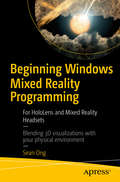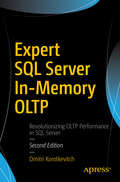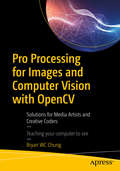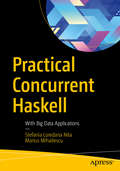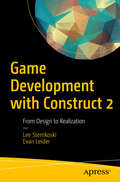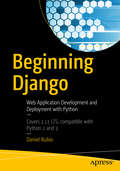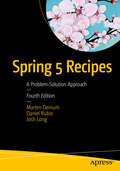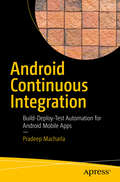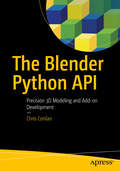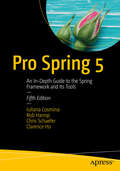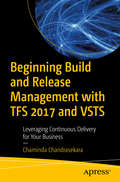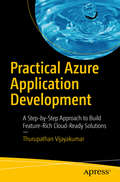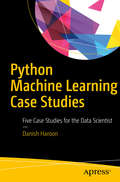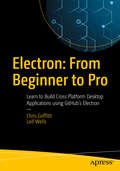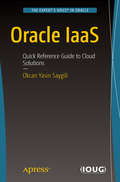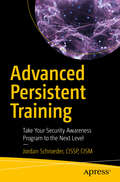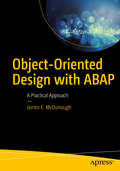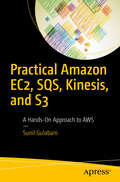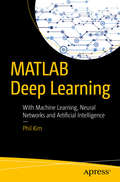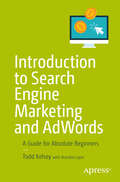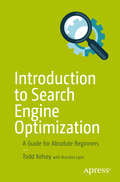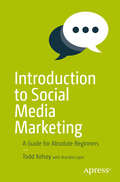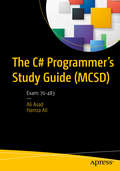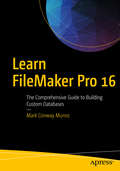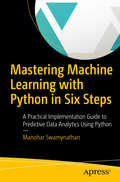- Table View
- List View
Beginning Windows Mixed Reality Programming: For HoloLens and Mixed Reality Headsets
by Sean OngDevelop applications and experiences for Microsoft's HoloLens and other Windows mixed reality devices. This easy-to-follow guide removes the mystery behind creating amazing augmented reality experiences. Mixed reality development tools and resources are provided. Beginning Windows Mixed Reality Programming clearly explains all the nuances of mixed reality software development. You'll learn how to create 3D objects and holograms, interact with holograms using voice commands and hand gestures, use spatial mapping and 3D spatial sound, build with Microsoft's HoloToolkit, create intuitive user interfaces, and make truly awe-inspiring mixed reality experiences. Start building the holographic future today! What You Will Learn Prototype ideas quickly Get started with Unity, the preferred tool for animating 3D objects. Explore where to find 3D models for your project, or make your own! Use spatial sound, voice commands, and gestures Build with the HoloToolkit to make apps the easy way Publish to the Windows Store and make money from your app Who This Book Is For Programmers with little or no graphics or mixed reality experience
Expert SQL Server In-Memory OLTP
by Dmitri KorotkevitchExpert SQL Server In-Memory OLTP is a deep dive into one of the most significant features of SQL Server 2014 - support for In-Memory Online Transaction Processing. The book describes the architecture and internals of the In-Memory OLTP Engine and explains how to develop, deploy, and maintain systems using it. With it you can dramatically increase transactional throughput to handle thousands of transactions per second supporting millions of customers. Dmitri Korotkevitch is the five-star author of Pro SQL Server Internals, and now brings his same combination of clear thinking and deep expertise to the question of how to recognize the opportunities and benefit from Microsoft's In-Memory OLTP feature set in SQL Server 2014. Learn the architecture and the internals in order to recognize when In-Memory OLTP can make a difference. Learn useful scenarios for thoughtfully incorporating in-memory support into existing applications. Recognize opportunities for In-Memory OLTP in new development. Don't be without Dmitri Korotkevitch and the deep expertise he imparts in Expert SQL Server In-Memory OLTP as you move forward in using SQL Server's new and important In-Memory OLTP feature set. Covers In-Memory OLTP internals and architecture, including data storage, indexing, multi-version concurrency control, transaction logging, and recovery Illustrates In-Memory OLTP programmability and the process of native compilation Guides in using In-Memory OLTP in new development and existing systems.
Pro Processing for Images and Computer Vision with OpenCV: Solutions for Media Artists and Creative Coders
by Bryan Wc ChungApply the Processing language to tasks involved in computer vision--tasks such as edge and corner detection, recognition of motion between frames in a video, recognition of objects, matching of feature points and shapes in different frames for tracking purposes, and more. You will manipulate images through creative effects, geometric transformation, blending of multiple images, and so forth. Examples are provided.Pro Processing for Images and Computer Vision with OpenCV is a step-by-step training tool that guides you through a series of worked examples in linear order. Each chapter begins with a basic demonstration, including the code to recreate it on your own system. Then comes a creative challenge by which to engage and develop mastery of the chapter’s topic. The book also includes hints and tips relating to visual arts, interaction design, and industrial best practices.This book is intended for any developer of artistic and otherwise visual applications, such as in augmented reality and digital effects, with a need to manipulate images, and to recognize and manipulate objects within those images. The book is specifically targeted at those making use of the Processing language that is common in artistic fields, and to Java programmers because of Processing’s easy integration into the Java programming environment. What You'll LearnMake use of OpenCV, the open source library for computer vision in the Processing environmentCapture live video streams and examine them frame-by-frame for objects in motionRecognize shapes and objects through techniques of detecting lines, edges, corners, and moreTransform images by scaling, translating, rotating, and additionally through various distortion effectsApply techniques such as background subtraction to isolate motion of objects in live video streamsDetect and track human faces and other objects by matching feature points in different images or video framesWho This Book Is ForMedia artists, designers, and creative coders
Practical Concurrent Haskell
by Stefania Loredana Nita Marius MihailescuLearn to use the APIs and frameworks for parallel and concurrent applications in Haskell. This book will show you how to exploit multicore processors with the help of parallelism in order to increase the performance of your applications. Practical Concurrent Haskell teaches you how concurrency enables you to write programs using threads for multiple interactions. After accomplishing this, you will be ready to make your move into application development and portability with applications in cloud computing and big data. You'll use MapReduce and other, similar big data tools as part of your Haskell big data applications development. What You'll Learn Program with Haskell Harness concurrency to Haskell Apply Haskell to big data and cloud computing applications Use Haskell concurrency design patterns in big data Accomplish iterative data processing on big data using Haskell Use MapReduce and work with Haskell on large clusters Who This Book Is For Those with at least some prior experience with Haskell and some prior experience with big data in another programming language such as Java, C#, Python, or C++.
Game Development with Construct 2
by Lee Stemkoski Evan LeiderDesign and create video games using Construct 2. No prior experience is required. Game Development with Construct 2 teaches you to create 12 different game projects from a variety of genres, including car racing and tower defense to platformer and action-adventure. The software is user friendly and powerful, and the games you create can be exported to run on the web, desktop computers, and smartphones. What You'll Learn Create complete functional games using the Construct 2 game engine Understand general logical structures underlying video game programs Use practical game design advice (such as visual feedback and gameplay balancing) Understand programming concepts useful throughout computer science Who This Book Is For Middle school and high school students with no prior programming knowledge, and only minimal mathematical knowledge (graphing (x,y) coordinates, measuring angles, and applying formulas)
Beginning Django: Web Application Development and Deployment with Python
by Daniel RubioDiscover the Django web application framework and get started building Python-based web applications. This book takes you from the basics of Django all the way through to cutting-edge topics such as creating RESTful applications. Beginning Django also covers ancillary, but essential, development topics, including configuration settings, static resource management, logging, debugging, and email. Along with material on data access with SQL queries, you'll have all you need to get up and running with Django 1. 11 LTS, which is compatible with Python 2 and Python 3. Once you've built your web application, you'll need to be the admin, so the next part of the book covers how to enforce permission management with users and groups. This technique allows you to restrict access to URLs and content, giving you total control of your data. In addition, you'll work with and customize the Django admin site, which provides access to a Django project's data. After reading and using this book, you'll be able to build a Django application top to bottom and be ready to move on to more advanced or complex Django application development. What You'll Learn Get started with the Django framework Use Django views, class-based views, URLs, middleware, forms, templates, and Jinja templates Take advantage of Django models, including model relationships, migrations, queries, and forms Leverage the Django admin site to get access to the database used by a Django project Deploy Django REST services to serve as the data backbone for mobile, IoT, and SaaS systems Who This Book Is For Python developers new to the Django web application development framework and web developers new to Python and Django.
Spring 5 Recipes
by Marten Deinum Daniel Rubio Josh LongSolve all your Spring 5 problems using complete and real-world code examples. When you start a new project, you'll be able to copy the code and configuration files from this book, and then modify them for your needs. This can save you a great deal of work over creating a project from scratch. The recipes in Spring 5 Recipes cover Spring fundamentals such as Spring IoC container, Spring AOP/ AspectJ, and more. Other recipes include Spring enterprise solutions for topics such as Spring Java EE integration, Spring Integration, Spring Batch, Spring Remoting, messaging, transactions, and working with big data and the cloud using Hadoop and MongoDB. Finally, Spring web recipes cover Spring MVC, other dynamic scripting, integration with the popular Grails Framework (and Groovy), REST/web services, and more. You'll also see recipes on new topics such as Spring Framework 5, reactive Spring, Spring 5 microservices, the functional web framework and much more. This book builds upon the best-selling success of the previous editions and focuses on the latest Spring Framework features for building enterprise Java applications. What You'll Learn Get re-usable code recipes and snippets for core Spring, annotations and other development tools Access Spring MVC for web development Work with Spring REST and microservices for web services development and integration into your enterprise Java applications Use Spring Batch, NoSQL and big data for building and integrating various cloud computing services and resources Integrate Java Enterprise Edition and other Java APIs for use in Spring Use Grails code and much more Who This Book Is For Experienced Java and Spring programmers.
Android Continuous Integration: Build-Deploy-Test Automation for Android Mobile Apps
by Pradeep MacharlaMaster continuous integration, deployment and automated testing for Android apps. You'll see how to set up and tear down sandbox environments to test the end-user experience, where you'll learn how to manage a mobile device in addition to the build machine. Android Continuous Integration applies a real-world CI pattern that has been thoroughly tested and implemented. This book starts with continuous integration concepts and the tools and code needed to become proficient in continuous integration for Android apps. You'll also follow acceptance test driven development (ATDD) best practice, giving you all the skills you need to become a better, more effective developer. Finally, you'll learn about the Appium mobile automation library and the Jenkins continuous integration tool. What You Will Learn Understand how to build an Android mobile app from source Set up a development or debuggi ng environment for mobile apps Integrate with the Nexus dependency management and application release tool Work with the SonarQube code quality analyzer Use debugging tools in Android Who This Book Is For Product owners/business analysts, QA/test engineers, developers and build/deploy engineers.
The Blender Python API
by Chris ConlanUnderstand Blender's Python API to allow for precision 3D modeling and add-on development. Follow detailed guidance on how to create precise geometries, complex texture mappings, optimized renderings, and much more.This book is a detailed, user-friendly guide to understanding and using Blender’s Python API for programmers and 3D artists. Blender is a popular open source 3D modeling software used in advertising, animation, data visualization, physics simulation, photorealistic rendering, and more. Programmers can produce extremely complex and precise models that would be impossible to replicate by hand, while artists enjoy numerous new community-built add-ons.The Blender Python API is an unparalleled programmable visualization environment. Using the API is made difficult due to its complex object hierarchy and vast documentation. Understanding the Blender Python API clearly explains the interface. You will become familiar with data structures and low-level concepts in both modeling and rendering with special attention given to optimizing procedurally generated models. In addition, the book:Discusses modules of the API as analogs to human input modes in BlenderReviews low-level and data-level manipulation of 3D objects in Blender PythonDetails how to deploy and extend projects with external librariesProvides organized utilities of novel and mature API abstractions for general use in add-on developmentWhat You’ll LearnGenerate 3D data visualizations in Blender to better understand multivariate data and mathematical patterns.Create precision object models in Blender of architectural models, procedurally generated landscapes, atomic models, etc.Develop and distribute a Blender add-on, with special consideration given to careful development practicesPick apart Blender’s 3D viewport and Python source code to learn about API behaviorsDevelop a practical knowledge of 3D modeling and rendering conceptsHave a practical reference to an already powerful and vast APIWho This Book Is ForPython programmers with an interest in data science, game development, procedural generation, and open-source programming as well as programmers of all types with a need to generate precise 3D models. Also for 3D artists with an interest in programming or with programming experience and Blender artists regardless of programming experience.
Pro Spring 5
by Iuliana Cosmina Rob Harrop Chris Schaefer Clarence HoPro Spring 2 is the perfect, simple answer for your lightweight, alternative Java EE development needs! Put simply, this book brings J2EE/Java EE "down to earth. " Without the hassles of using the EJB 3 specification and similar, you can build lighter, better-performing agile enterprise Java-based applications using Spring Framework 2. The Spring framework can also integrate other noteworthy and hot open source tools like Apache Struts, Hibernate, OpenJPA, GlassFish, and many more. You'll work through a real, scalable enterprise application and build it from the ground up with Spring, using all the multiple web views and frameworks.
Beginning Build and Release Management with TFS 2017 and VSTS
by Chaminda ChandrasekaraMaster build and release management with Team Foundation Service and Visual Studio Team Services to facilitate the continuous delivery of software updates to your development team.You'll receive detailed, practical guidance on automating website deployments in Azure App Service, database deployments to Azure platform, Micro Services deployments in Azure Service Fabric, and more. Each deployment is structured with the aid of hands-on lessons in a given target environment designed to empower your teams to achieve successful DevOps. This book provides lessons on how to optimize build release management definitions using capabilities, such as task groups. With the help of practical scenarios, you’ll also learn how to diagnose and fix issues in automated builds and deployments. You’ll see how to enhance the capability of build and release management, using team services/TFS Marketplace extensions and writing your own extensions for any missing functionality via hands-on lessons.What You Will LearnAutomate deployment to Azure platform, including Web App Service, Azure SQL and Azure Service FabricTest automation integration with builds and deploymentsPerform Dynamic CRM deployment handling and package management with TFS/VSTSExamine requirement to production delivery traceability in practical terms Review cross platform build/deployment capabilities of TFS/VSTS. Who This Book Is ForBuild/Release Engineers, Configuration Managers, Software Developers, Test Automation Engineers, System Engineers, Software Architects and System/Production Support Engineers or anyone who handles and involves in the software delivery process.
Practical Azure Application Development
by Thurupathan VijayakumarGet started and learn a step-by-step approach to application development using Microsoft Azure. Select the right services to solve the problem at hand in a cost-effective manner and explore the potential different services and how they can help in building enterprise applications. Azure has an ample amount of resources and tutorials, but most of them focus on specific services and explain those services on their own and in a given context. Practical Azure Application Development focuses on building complete solutions on Azure using different services. This book gives you the holistic approach to Azure as a solutions development platform. This book: Covers Azure as a solution development platform for building applications Provides real-world examples to understand why and when an Azure service is required Discusses how Azure helps to achieve continuous improvement and expansion of an application Provides application development experience from purchasing Azure to integrating with core Azure services, including an introduction to DevOps with VSTS What You'll Learn Use Azure services to solve real-world software problems Define the usage of Azure services and select the right services to solve the problem at hand Make clear and less ambiguous decisions about using different Azure services Take a holistic approach to Azure as a solution platform Understand the basics of security, data protection, and cost controls in Azure Who This Book Is For Developers, software engineers, and architects who have experience in . NET and web development, but have little or no knowledge in planning and developing an application on Azure
Python Machine Learning Case Studies
by Danish HaroonEmbrace machine learning approaches and Python to enable automatic rendering of rich insights and solve business problems. The book uses a hands-on case study-based approach to crack real-world applications to which machine learning concepts can be applied. These smarter machines will enable your business processes to achieve efficiencies on minimal time and resources. Python Machine Learning Case Studies takes you through the steps to improve business processes and determine the pivotal points that frame strategies. You'll see machine learning techniques that you can use to support your products and services. Moreover you'll learn the pros and cons of each of the machine learning concepts to help you decide which one best suits your needs. By taking a step-by-step approach to coding in Python you'll be able to understand the rationale behind model selection and decisions within the machine learning process. The book is equipped with practical examples along with code snippets to ensure that you understand the data science approach to solving real-world problems. What You Will Learn Gain insights into machine learning concepts Work on real-world applications of machine learning Learn concepts of model selection and optimization Get a hands-on overview of Python from a machine learning point of view Who This Book Is For Data scientists, data analysts, artificial intelligence engineers, big data enthusiasts, computer scientists, computer sciences students, and capital market analysts.
Electron: From Beginner to Pro
by Chris Griffith Leif WellsDiscover how to take your existing web development skills and learn how to create desktop applications for macOS, Windows, and Linux, using GitHub's Electron. Learn how to combine the power of Node. js and Chromium to provide a powerful development platform for creating web applications that break free from the browser. Electron: From Beginner to Pro guides you through the capabilities that you have available to create desktop applications. Learn to use features like file system access, create native menus, OS-specific dialogs and more. The authors will show you how to package your application for distribution for multiple platforms and enable auto-updating. What You Will Learn Leverage your knowledge of HTML, CSS and JavaScript Use current web applications for the desktop Create and use Electron's main process and render process to create effective desktop applications Communicate between processes and between windows Build desktop applications that can be updated and distributed Who This Book Is For Web developers looking to leverage their HTML, CSS and JavaScript skills to create desktop widgets and applications. Developers wanting to leverage existing a Web application to extend functionality with a desktop application.
Oracle IaaS
by Okcan Yasin SaygiliFollow this guide that explains Oracle's Infrastructure as a Service (IaaS) cloud solution and the tools and capabilities that can help you increase business value, productivity, and performance. You will learn about economic advantages as well as elasticity, unlimited storage, and on-demand capacity computing. Oracle IaaS: Quick Reference Guide to Cloud Solutions covers Oracle's service structure as well as its cloud service offerings and cloud models. It provides detailed guidance regarding the advantages of the specific models, as well as how to create and manage each service. This book contains many real-world case studies, including how to build and configure compute resources to fit the needs of your specific organization. IaaS product offerings covered in this book include: Oracle Compute Cloud Oracle Storage Cloud Oracle Ravello Cloud Oracle Container Cloud What You'll Learn Understand Oracle IaaS products and Oracle Cloud Compare existing Oracle cloud products Discover IaaS new features Master Oracle Cloud Architecture Who This Book Is For Oracle database administrators, Oracle developers, and other developers looking to build cloud-based applications.
Advanced Persistent Training: Take Your Security Awareness Program to the Next Level
by Jordan SchroederGain greater compliance with corporate training by addressing the heart of the very awareness vs. compliance problem: people are human. People have incredible strengths and incredible weaknesses, and as a Information Security professional, you need to recognize and devise training strategies that take advantage of both. This concise book introduces two such strategies, which combined, can take a security awareness program to the next level of effectiveness, retention, compliance, and maturity. Security policies and procedures are often times inconvenient, technically complex, and hard to understand. Advanced Persistent Training provides numerous tips from a wide range of disciplines to handle these especially difficult situations. Many information security professionals are required by regulation or policy to provide security awareness training within the companies they work for, but many believe that the resulting low compliance with training does not outweigh the costs of delivering that training. There are also many who believe that this training is crucial, if only it could be more effective. What you will learn: Present awareness materials all year-round in a way that people will really listen. Implement a "behavior-first" approach to teaching security awareness. Adopt to gamification the right way, even for people who hate games. Use tips from security awareness leaders addressing the same problems you face. Who is this book for Security awareness professionals or IT Security professionals who are tasked with teaching security awareness within their organization.
Object-Oriented Design with ABAP
by James E. McdonoughConquer your fear and anxiety learning how the concepts behind object-oriented design apply to the ABAP programming environment. Through simple examples and metaphors this book demystifies the object-oriented programming model. Object-Oriented Design with ABAP presents a bridge from the familiar procedural style of ABAP to the unfamiliar object-oriented style, taking you by the hand and leading you through the difficulties associated with learning these concepts, covering not only the nuances of using object-oriented principles in ABAP software design but also revealing the reasons why these concepts have become embraced throughout the software development industry. More than simply knowing how to use various object-oriented techniques, you'll also be able to determine whether a technique is applicable to the task the software addresses. This book: Shows how object-oriented principles apply to ABAP program design Provides the basics for creating component design diagrams Teaches how to incorporate design patterns in ABAP programs What You'll Learn Write ABAP code using the object-oriented model as comfortably and easily as using the procedural model Create ABAP design diagrams based on the Unified Modeling Language Implement object-oriented design patterns into ABAP programs Reap the benefits of spending less time designing and maintaining ABAP programs Recognize those situations where design patterns can be most helpful Avoid long and exhausting searches for the cause of bugs in ABAP programs Who This Book Is For Experienced ABAP programmers who remain unfamiliar with the design potential presented by the object-oriented aspect of the language >
Practical Amazon EC2, SQS, Kinesis, and S3
by Sunil GulabaniProvide solutions to all your Amazon EC2, SQS, Kinesis, and S3 problems, including implementation using the AWS Management Console, AWS CLI, and AWS SDK (Java). You'll find recipes on implementation and configuration of Amazon EC2, SQS, Kinesis, and S3 along with the code snippets and AWS CLI commands. Practical Amazon EC2, SQS, Kinesis, and S3 uses focused examples that include only the details you need to get things done. You'll see production use cases of Amazon EC2, SQS, Kinesis, and S3 and how to implement cloud watch in projects for these services. Learn how to raise an alarm on Amazon EC2, SQS, Kinesis, and S3 as part of a continuous monitoring system designed to increase performance and avoid side effects in your services. What You'll Learn Manage Amazon EC2, SQS, Kinesis, and S3 using the AWS Management Console Use the AWS CLI Employ the AWS Java SDK Configure alarms on Amazon EC2, SQS, Kinesis, and S3 Who This Book Is For Software developers and architects, system engineers, and project managers
MATLAB Deep Learning
by Phil KimThis book consists of six chapters, which can be grouped into three subjects. The first subject is Machine Learning and takes place in Chapter 1. Deep Learning stems from Machine Learning. This implies that if you want to understand the essence of Deep Learning, you have to know the philosophy behind Machine Learning to some extent. Chapter 1 starts with the relationship between Machine Learning and Deep Learning, followed by problem solving strategies and fundamental limitations of Machine Learning. The detailed techniques are not introduced yet. Instead, fundamental concepts that applies to both the neural network and Deep Learning will be covered. The second subject is artificial neural network. Chapters 2-4 focuses on this subject. As Deep Learning is a type of Machine Learning that employs a neural network, the neural network is inseparable from Deep Learning. Chapter 2 starts with the fundamentals of the neural network: principles of its operation, architecture, and learning rules. It also provides the reason that the simple single-layer architecture evolved to the complex multi-layer architecture. Chapter 3 presents the backpropagation algorithm, which is an important and representative learning rule of the neural network and also employed in Deep Learning. This chapter explains how cost functions and learning rules are related and which cost functions are widely employed in Deep Learning. Chapter 4 introduces how to apply the neural network to classification problems. We have allocated a separate section for classification because it is currently the most prevailing application of Machine Learning. For example, image recognition, one of the primary applications of Deep Learning, is a classification problem. The third topic is Deep Learning. It is the main topic of this book as well. Deep Learning is covered in Chapters 5 and 6. Chapter 5 introduces the drivers that enables Deep Learning to yield excellent performance. For a better understanding, it starts with the history of barriers and solutions of Deep Learning. Chapter 6 covers the convolution neural network, which is representative of Deep Learning techniques. The convolution neural network is second-to-none in terms of image recognition. This chapter starts with an introduction of the basic concept and architecture of the convolution neural network as it compares with the previous image recognition algorithms. It is followed by an explanation of the roles and operations of the convolution layer and pooling layer, which act as essential components of the convolution neural network. The chapter concludes with an example of digit image recognition using the convolution neural network and investigates the evolution of the image throughout the layers.
Introduction to Search Engine Marketing and AdWords: A Guide For Absolute Beginners
by Todd KelseyUse Google's AdWords to create your ads. Each chapter goes beyond the tool itself, discussing helpful resources and important issues to keep in mind. If you are completely new to search engine marketing and AdWords and you want to learn the basics, this guide will introduce you to the content quickly. Introduction to Search Engine Marketing and AdWords is not in-depth, comprehensive, or trying to cover every tool or platform--an impossible task! But it is an easy-to-understand introduction to the most important tools and skills in search engine marketing. What You'll Learn Take a behind-the-scenes tour of AdWords, including how to create an account Create and launch a campaign as well as ads, including keyword tools Monitor a campaign, including time frame, clicks and CTR, and reporting Implement various campaign strategies, including support email and dealing with errors Use Ad extensions as well as site links Who This Book Is For Those who need to get up to speed on search engine marketing tools and techniques for business or personal use. This book is also suitable as a student reference.
Introduction to Search Engine Optimization: A Guide For Absolute Beginners
by Todd KelseyDon't be intimidated by all the search engine optimization (SEO) tools out there. You will start out learning about keywords and the importance of quality content and then walk through incremental steps as you try out the tools and master the tips and strategies. If you are completely new to search engine optimization and you want to learn the basics, this guide will introduce you to the content quickly. Introduction to Search Engine Optimization is a detailed guide to the most important tools and skills needed to accurately and effectively utilize search engine optimization. This book covers SEO basics, keyword research, SEO ranking and analytics, Google Analytics, and more. It also includes an overview of how to pursue SEO-related certifications. What You'll Learn Create a content platform, including blogs and YouTube channels Use keywords to maximize findability and increase search volume Check your SEO rank and other analytics Hunt for duplicate content Set up Google Analytics, including Blogger Utilize Indexing and Webmaster tools/search console Who This Book Is For Those who need to get up to speed on search engine optimization tools and techniques for business or personal use. This book is also suitable as a student reference.
Introduction to Social Media Marketing: A Guide For Absolute Beginners
by Todd KelseyEasily understand the most important tools and skills in social media marketing. You'll be exposed to Facebook pages and ads, work with Twitter and LinkedIn, save time with Hootsuite, and learn social media monitoring. If you are completely new to social media marketing and you want to learn the basics, this guide will introduce you to the content quickly. Introduction to Social Media Marketing has a particular focus on ROI (return on investment), to help you think critically about the value social media could bring a business or organization. You'll explore the question of whether or not it's worth it to invest time and money in each social media channel. What You'll Learn Understand basic functions for most social media tools, including how to get up and running See the benefits of social media tools and which one you should use for specific purposes Calculate the real ROI expected from using specific tools Utilize social media monitoring and analytics Who This Book Is For Those who need to get up to speed on a broad range of social media tools and techniques for business or personal use. This book is also suitable as a student reference.
The C# Programmer’s Study Guide (MCSD)
by Ali Asad Hamza AliPrepare for Microsoft Certification Exam 70-483: Programming in C#. The "What, Why, and How" of each concept is presented along with quick summaries, code challenges, and exam questions to review and practice key concepts. You will learn how to use: Lambda expressions to write LINQ query expressions Asynchronous programming with the Async and Await keywords to maximize performance of slow applications Regular expressions to validate user input Reflection to create and handle types at runtime and much more The source code in the book will be available in the form of iCanCSharp notebooks and scripts that allow you to try out examples and extend them in interesting ways. What You Will Learn Understand the necessary knowledge and skill set to prepare for Microsoft Exam 70-483 Study the code challenges and practice questions on C# that are relevant to the exam Master the C# programming language Who This Book Is For Experienced C# and . NET programmers and developers who are ready to take and pass the exam in order to get certified
Learn FileMaker Pro 16: The Comprehensive Guide to Building Custom Databases
by Mark Conway MunroExtend FileMaker's built-in functionality and totally customize your data management environment with specialized functions and menus to super-charge the results and create a truly unique and focused experience. This book includes everything a beginner needs to get started building databases with FileMaker and contains advanced tips and techniques that the most seasoned professionals will appreciate. Written by a long time FileMaker developer, this book contains material for developers of every skill level. FileMaker Pro 16 is a powerful database development application used by millions of people in diverse industries to simplify data management tasks, leverage their business information in new ways and automate many mundane tasks. A custom solution built with FileMaker can quickly tap into a powerful set of capabilities and technologies to offer users an intuitive and pleasing environment in which to achieve new levels of efficiency and professionalism. What You’ll learnCreate SQL queries to build fast and efficient formulasDiscover new features of version 16 such as JSON functions, Cards, Layout Object window, SortValues, UniqueValues, using variables in Data Sources Write calculations using built-in and creating your own custom functionsDiscover the importance of a good approach to interface and technical designApply best practices for naming conventions and usage standards Explore advanced topics about designing professional, open-ended solutions and using advanced techniquesWho This Book Is ForCasual programmers, full time consultants and IT professionals.
Mastering Machine Learning with Python in Six Steps
by Manohar SwamynathanMaster machine learning with Python in six steps and explore fundamental to advanced topics, all designed to make you a worthy practitioner. This book's approach is based on the "Six degrees of separation" theory, which states that everyone and everything is a maximum of six steps away. Mastering Machine Learning with Python in Six Steps presents each topic in two parts: theoretical concepts and practical implementation using suitable Python packages. You'll learn the fundamentals of Python programming language, machine learning history, evolution, and the system development frameworks. Key data mining/analysis concepts, such as feature dimension reduction, regression, time series forecasting and their efficient implementation in Scikit-learn are also covered. Finally, you'll explore advanced text mining techniques, neural networks and deep learning techniques, and their implementation. All the code presented in the book will be available in the form of iPython notebooks to enable you to try out these examples and extend them to your advantage. What You'll Learn Examine the fundamentals of Python programming language Review machine Learning history and evolution Understand machine learning system development frameworks Implement supervised/unsupervised/reinforcement learning techniques with examples Explore fundamental to advanced text mining techniques Implement various deep learning frameworks Who This Book Is For Python developers or data engineers looking to expand their knowledge or career into machine learning area. Non-Python (R, SAS, SPSS, Matlab or any other language) machine learning practitioners looking to expand their implementation skills in Python. Novice machine learning practitioners looking to learn advanced topics, such as hyperparameter tuning, various ensemble techniques, natural language processing (NLP), deep learning, and basics of reinforcement learning.
